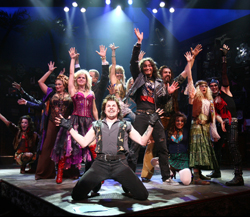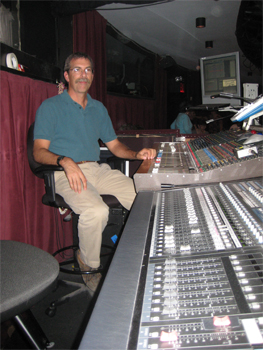
South Pacific
It’s the first-ever Broadway revival of South Pacific, the 1949 Rodgers and Hammerstein musical that originally won 10 Tony awards.
In 2008, sound designer Scott Lehrer was the first recipient of the Tony for Sound Design, and South Pacific won 5 Drama Desk and 6 other Tony awards. There are a plethora of hits before Act I is half over: “Some Enchanted Evening,” “Bloody Mary,” “Nothing Like a Dame,” “Bali Ha’i,” “Wash That Man Right Outa My Hair” and “I’m In Love With a Wonderful Guy.”
The Vivian Beaumont Theater (cap. 1,080) on the Lincoln Center complex’s north side on West 66th Street is Manhattan’s only Broadway-class theater not located in the Times Square area. It has an unusual semi-circular, five section “stadium” configuration with a five row loge just above. The orchestra sits beneath a retractable thrust stage, which opens before each act.
There are two consoles at 10-year veteran Marc Salzberg’s mix position. A Cadac J-Type with 15 VCAs and programmable inputs handles the principle actors’ mics.
Eight of its 15 VCAs are linked to the DCAs of a 4-layer, 96-channel Yamaha PM5D-EX with a MIDI interface from Masque’s Gary Stocker. The first layer handles chorus mics, the second mixes 16 channels of Q-Lab sound effects, while the third and fourth control orchestra mics.
A unique yet simple device is Lehrer’s use of Yamaha DME-64 DSP matrixes to pan the principles’ mics via delay according to their position in one of seven stage zones: L-C-R, up- and mid-stage, plus a single upstage zone. The additional delay for characters up- and off-stage provides subtle realism to the sound reinforcement. It seems simple, but is surprisingly effective.
The national tour opened in September at San Francisco’s Golden Gate Theater, and Lehrer has redesigned the show around a Studer Vista 5 console.
.
The overhead system consists of a semi-circular “exploded” array of a half-dozen d&b audiotechnik C-7 loudspeakers for orchestra reinforcement, plus five over-and-under pairs of 75- x 15-degree d&b Q-1 loudspeakers slung from the catwalk for vocals.
Left and right proscenium arrays are a Q-Sub, above two Q-1 loudspeakers, with a 75 x 40 Q-7 beneath and a Q-Sub below on the deck. Front-fill loudspeakers consist of four Meyer M1Ds, two d&b E-0 and a pair of Meyer MM-4 around maestro Lassen at center.
Over the stage pairs of Meyer MSL-4 pointed down from the catwalk and the grid provide overhead sound effects. On the deck a pair of Meyer CQ-2 provides up-stage sound effects, while another pair overhead provides the orchestra. Side-fills are a pair of EAW JF80s down-stage and a pair of JF200s up-stage. The surround system consists of double sets of EAW JF80 and JF60 loudspeakers behind the orchestra and loge sections, powered with Yamaha M5000 amps and driven by a Lexicon 960.
One practical sound source is a four-horn 360-degree array of Altec multi-cell horns used for a PA effect in the second act’s Thanksgiving show. Another practical sound source is driven by Sennheiser e300 IEM G2 wireless receivers and 12 V car amps for radio transmissions.
The actors are mic’d with DPA 4061s except for Laura Osnes’ Nellie Forbush character, who wears two Countryman D3, since she has to “Wash that man right out of her hair” with soap and water on stage, and then deliver another 20 minutes of dialog. Besides main and backup mics at his hair-line, operatic singer Paulo Szot, who plays French expatriate Emile de Becque, has a third mic to catch his chest resonance.

